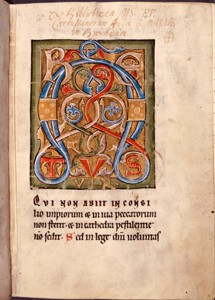 One of the most astonishing features of the Lord’s Prayer is its beginning. There are many ways to call upon God: many titles, many names, many descriptors. But the model Jesus provides is a unique and remarkable pattern for addressing God. With an incredible economy of words, he challenges traditional notions of God, and highlights two important aspects of his nature: his immanence and his transcendence.
One of the most astonishing features of the Lord’s Prayer is its beginning. There are many ways to call upon God: many titles, many names, many descriptors. But the model Jesus provides is a unique and remarkable pattern for addressing God. With an incredible economy of words, he challenges traditional notions of God, and highlights two important aspects of his nature: his immanence and his transcendence.
Our Father. Living in the anno domini side of history, we take for granted that God is our father. This seems a normal way to speak about God. Yet it is anything but normal. Other religions don’t speak of God in this way. Some religions don’t even have a personal view of God (Buddhism for instance). Others do view God as a person, but still don’t refer to him as father – certainly not Islam, but this is also largely true of Judaism.
In the time of Jesus it was not unusual within Judaism to talk about God as father in a sort of loose metaphorical sense. But Jesus does something quite revolutionary when he speaks about God as His Father. His opponents recognized this and found it blasphemous:
John 5:18 18 For this reason the Jews tried all the harder to kill him; not only was he breaking the Sabbath, but he was even calling God his own Father, making himself equal with God.
Jesus also uses an even more familiar form – the Aramaic Abba (Mark 14:36), which some have argued would carry the weight of a childlike “Daddy.” And he sweeps us up with himself into this remarkable personal relationship with God by teaching us to pray Our Father.
It is important to note here that in the sense Jesus teaches here, God is not the Father of all men. God is the Father of his children. And childhood of God is not a natural right, it is one received when we are adopted into the household of God through faith in Jesus Christ:
John 1:12-13 12 Yet to all who received him, to those who believed in his name, he gave the right to become children of God– 13 children born not of natural descent, nor of human decision or a husband’s will, but born of God.
The intimate nature of our relationship with the Father has enormous implications for our prayer lives as is seen in several teachings of Jesus, particularly the lesson concerning the desire of God to give good gifts to his children (Luke 11:11-13 – we’ll revisit this another time). God is present in the lives of his children like any good father is. He cares for his children, watches over them, provides for them, loves them.
We call this doctrine of God’s nearness and presence with us divine immanence. The Christian God is not sitting up in the heavens, aloof and remote, removed from interaction with his creatures. He is here; he is present in our midst. This is captured most powerfully in the great Immanuel biblical theme: God with us – whether in pillar of cloud and fire, in the Ark of the Covenant, in his manifest Shekinah glory in the Temple, or most ultimately in the incarnation of the Lord Jesus Christ and the abiding presence of the Holy Spirit – God is with us!
Who Art in Heaven. Jesus teaches us to pray to God in a personal intimate way as Our Father, but he adds a modifier that we translate as a relative clause: “who art in heaven.” The language of “art” is obviously archaic. We aren’t talking about painting or sculpture; we would say “is” here in common speech. Modern translations go with “Our Father in heaven,” or, appropriately (since this is what this means), “Our heavenly Father.”
What is the significance of this additional descriptor? It serves as a check to a certain kind of error. While many systems of belief have a view of God that is too transcendent, or removed, from his Creation (Islam, for one), other systems of belief get carried away in the opposite direction. God is viewed as being overly immanent – he can be identified with the Creation itself. You see this in forms of Pantheism (Buddhism is essentially pantheistic), but also in many other forms of Monism (such as New Age “spirituality”). You also see it in some really bad theological systems (like Process Theology).
God is intimately present in his Creation – in fact, he ultimately enters into his Creation to affect the redemption of the world via the incarnation. But he is also distinct from Creation. He Created Creation. He reigns transcendent over it. He is not like his creatures. He is “Holy! Holy! Holy!” Jesus reminds us of this by teaching us to call upon our heavenly Father. Though our Father, God is still God. As such, we reverence him; we fear him; we recognize (and we pray in light of) his transcendent glory.
Jesus teaches us to avoid the Scylla and Charybdis of both a radically immanent and a radically transcendent God. Both are serious errors and will lead to tremendous problems in our understanding of the God we serve. Instead he models for us a life of devotion to a God with whom we can both know intimate care and relationship (Our Father), but also a God who reigns supremely in majesty and glory over his creatures (Who Art In Heaven).